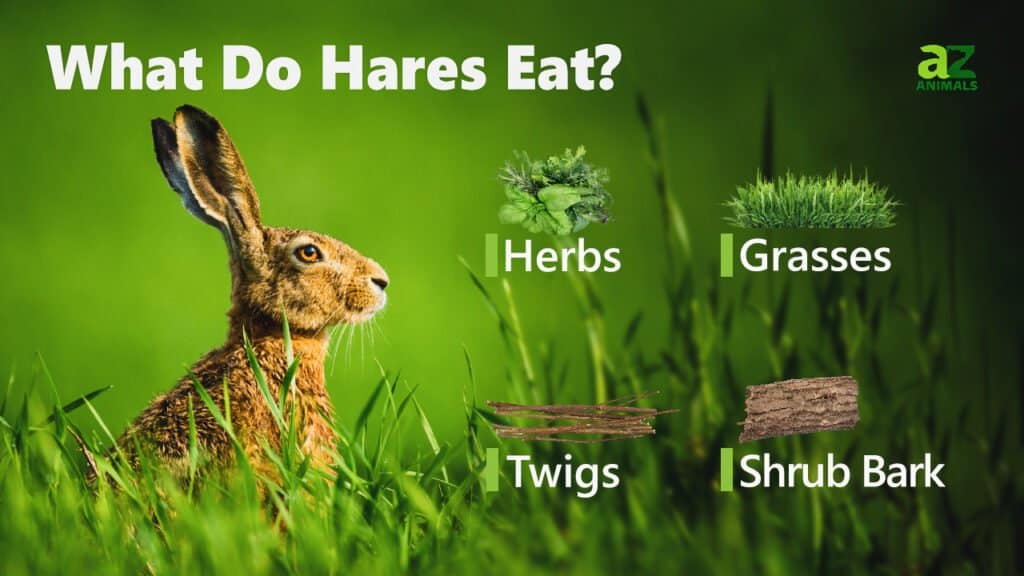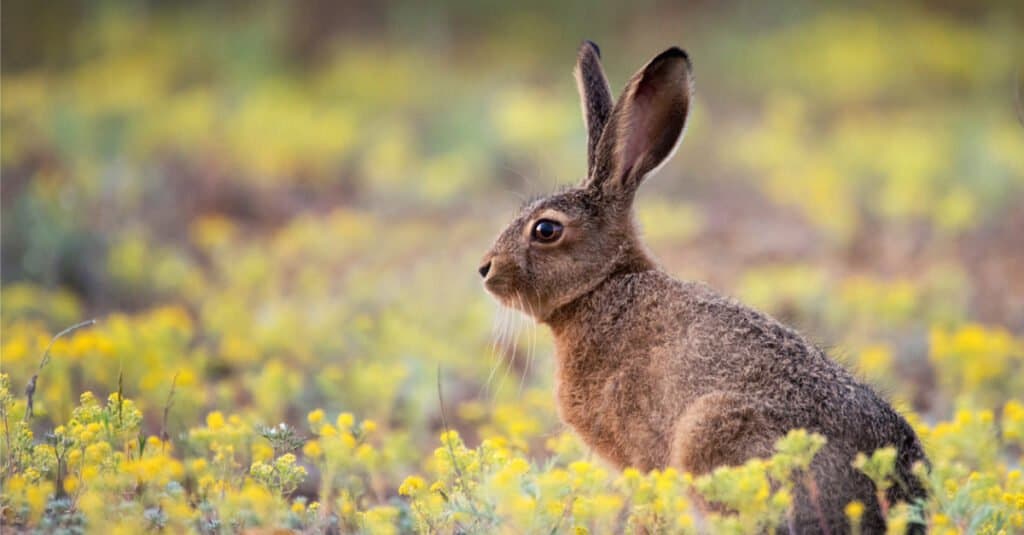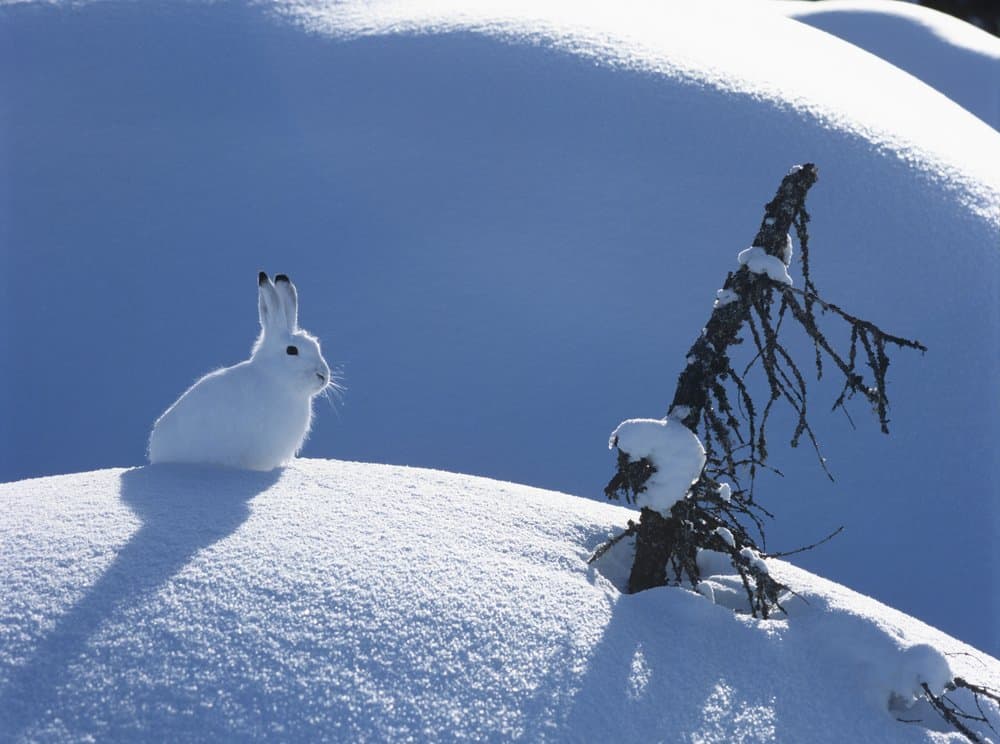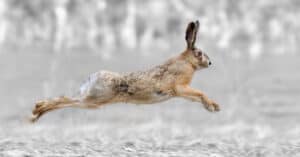Hares are small mammals, often associated with rabbits and bunnies. They often have long, large ears, and big hind feet, and hop as their primary mode of locomotion. They live on almost every continent (save Antarctica) and are some of the fastest breeding and adaptable animals on the planet. Let’s learn and discover: What do hares eat?
What Do Hares Eat?

Hares are some of the most adaptable animals on the planet and live in some of the harshest environments. As a result, their diets are adaptable and reflect their living conditions.
Hares are herbivorous animals that primarily eat tough grasses. They are able to eat almost any grass but prefer the kinds that are usually dried and turned into hay. Of those types, timothy hay, orchard hay, and oat hay are the favorites of hares and rabbits alike.
Additionally, a hare will supplement its diet with fruits, nuts, berries, and any other items it can forage, mostly being determined by its locale. Unlike most animals that eat grass, rabbits are not ruminants. Ruminants are animals that have a specialized organ known as a “rumen” with evolved bacteria and enzymes to break down grass. Since hares lack this, they are known to go through a process of digestion known as “hindgut” fermentation. Essentially, a hare will often eat its own fecal matter to digest it a second time and get more nutrients out.
A Complete List of Foods That Hares Eat
Here is a list of the foods that hares eat:
- a variety of grasses depending on their region
- berries
- fruits
- nuts
- fungi
- woody plants
- mosses
- lichens
- bark
- flowers
- garden plants
- their own poop
How Do Hares Get Their Food?

Hares forage during dusk and dawn to avoid predators.
©iStock.com/MriyaWildlife
Hares are nocturnal animals that spend most of their day hiding before heading out to forage and graze at night. Since they are near the bottom of the food chain and operate as one of the primary food sources for almost every predator on every continent they are found, this nocturnal strategy is used to help them survive. They are primarily foragers and don’t have any type of specialized “hunting” strategy. Their diets are seasonal and depend on availability.
One of the more interesting adaptations that hares have developed is their method of digestion. Since they don’t have rumens (an organ to process tough grasses), they use a method of digestion known as hindgut fermentation. Although it’s a scientific-sounding process, it’s essentially just the practice of eating their own poop again in order to run the nutrients through their digestive line again.
What Is The Difference Between a Hare and a Rabbit?
Hares and rabbits may seem similar, but they are actually more than just different names for the same thing. Hares and rabbits both belong to the same family, Leporidae, and even the same order, Lagomorpha, but they are distinctly different species. Additionally, they have different amounts of chromosomes, making interbreeding impossible.
What Kinds of Species of Hare Are There?

Hares live on almost every continent in the world and are highly adaptable.
©sirtravelalot/Shutterstock.com
There are over 32 species of hare across the world, with at least one hare species being present on every continent, except Antarctica.
Some of the most famous species of hare in the world are, the Arctic hare, the Cape hare, and the snowshoe hare. The Arctic hare has specially adapted to survival in the arctic through reduced ear size, increased levels of body fat, and a thicker coat of fur than any other hare species. The Cape hare is known as one of the fastest hares in the world. It has been recorded hitting speeds as fast as 45 mph when running from predators. The snowshoe hare is known for its incredibly large feet, allowing it to run on top of deep snow, an important survival benefit in the far north.
Additionally, jackrabbits are classified as hares, as seen in their other name, the American desert hare. They are found in the United States and Mexico, primarily in dry and arid regions higher than 10,000 feet above sea level.
Where Do Hares Live?
Hares live on every continent in the world except Antarctica. In most regions, hares prefer open areas like meadows, grasslands, deserts, and tundra. Almost all species of hare can be found within these different open regions, with all of them having special adaptations to the region and its predators.
There are a few species that live in forested or mountainous regions, but generally, any open regions are likely home to hares.
What Animals Compete with Hares?

Hares go through boom-bust cycles as their populations explode and crash.
©Gilad.rom, CC BY 3.0, via Wikimedia Commons – License
Hares are extremely low on the food chain and are often the primary source of food for many species of predators in the wild. Outside of predators, hares don’t have many competitors that directly compete with them. Their main competition would be any other animals that share their food sources.
One of the more recently discovered competitions is, strangely enough, between snowshoe hares and moose in North America. Their competition is due to a shared food resource, as the Michigan-based study discovered.
Why Are Hares so Important for Other Predators?
Hares predation is incredibly common for all sorts of predators in almost all areas of the world. Humans are some of their top predators, and they have been a historic food source for native peoples worldwide.
Outside of humans, foxes, bobcats, eagles, hawks, owls, coyotes, bears, weasels, and lynx are all dependent on hares as some of their primary sources of food. In many regions, hares go through “boom and bust” cycles where the population grows incredibly fast before crashing again. This cycle is generally repeated every 8-11 years, and since hares are so foundational to most ecosystems they are in, the cycle impacts every other predatory creature that preys on them.
The photo featured at the top of this post is © RRichard29/Shutterstock.com
Thank you for reading! Have some feedback for us? Contact the AZ Animals editorial team.






